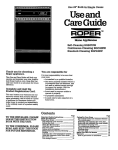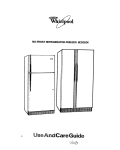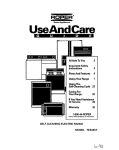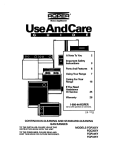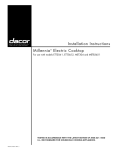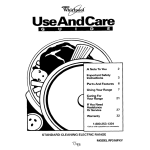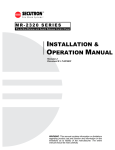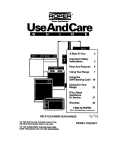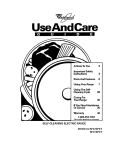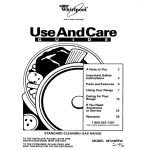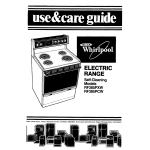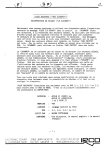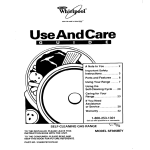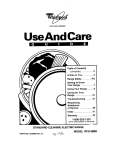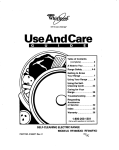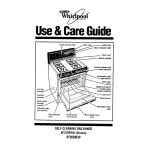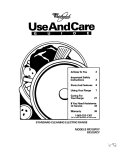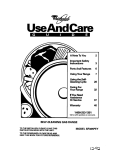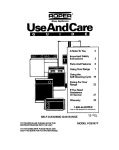Download Whirlpool FGS395Y User's Manual
Transcript
UseAndCare A Note To You 2 Important Safety Instructions 3 Parts And Features 6 Using Your Range 7 Usin the Setf- E leaning Cycle 23 Caa;~ For Your 27 If You Need ptk&tg . 32 Warranty 36 l-800-44-ROPER Call us with questions SELF-CLEANING TO THE INSTALLER: PLEASE LEAVE THIS INSTRUCTION BOOK WITH THE UNIT. TO THE CONSUMER: PLEASE READ AND KEEP THIS BOOK FOR FUTURE REFERENCE. or comments. GAS RANGE MODEL FGS395Y A Note To You Thank you for buying a Roper appliance. You have purchased a quality, worldclass home appliance. Years of engineering experience have gone into its manufacturing. To ensure that you will enjoy many years of trouble-free operation, we have developed this Use and Care Guide. It is full of valuable information on how to operate and maintain your appliance properly and safely. Please read it carefully. Also, please complete and mail the Ownership Registration Card provided with your appliance. This will help us notify you about any new information on your appliance. Your safety is important to us. This guide contains safety symbols and statements. Please pay special attention to these symbols and follow any instructions given. Here is a brief explanation of the use of each symbol. This symbol will help alert you to such dangers as personal injury, burns, fire and electrical shock. This symbol will help you avoid actions which could cause product damage (scratches, dents, etc.) and damage to your personal property. l l l l ALL RANGES CAN TIP. INJURY TO PERSONS COULD RESULT. INSTALL ANTI-TIP DEVICES PACKED WITH RANGE. SEE INSTALLATION INSTRUCTIONS. For more information, see the ‘The anti-tip bracket” on page 22. Our toll available free number, l-800-44-ROPER 24 hours a day. (l-800-447-67371, is If you ever have a question concerning your appliance’s operation, or if you need service, first see “If You Need Assistance Or Service” on page 32. If you need further help, feel free to call us. When calling, you will need to know your appliance’s complete model number and serial number. You can find this information on the model and serial number plate (see diagram on page 6). For your convenience, we have included a handy place below for you to record these numbers, the purchase date from the sales slip and your dealer’s name and telephone number. Keep this book and the sales slip together in a safe place for future reference. Model Number Dealer Name Serial Number Dealer Phone Purchase 2 Date Important Safety Instructions Gas ranges have been thoroughly tested for safe and efficient operation. However, as with any appliance, there are specific installation and safety precautions which must be followed to ensure safe and satisfactory operation. To reduce the risk of fire, electrical shock, injury to persons, or damage when using the range, follow basic precautions, including WARNING: if the information in this manual is not followed exactly, a fire or explosion may result causing property damage, personal injury or death. Do not store or use gasoline or other flammable vapors and liquids in the vicinity of this or any other appliance. WHAT TO DO IF YOU SMELL GAS: l Do not try to light any appliance. l Do not touch any electrical switch; do not use any phone in your building. l immediately call your gas supplier from a neighbor’s phone. Follow the gas supplier’s instructions. l if you cannot reach your gas supplier, call the fire department. installation and service must be performed by a qualified installer, service agency or the gas supplier. General l Install or locate the range only in accordance with the provided Installation Instructions. The range must be installed by a qualified installer. The range must be properly connected to the proper gas supply and checked for leaks. The range must also be properly connected to electrical supply and grounded. l Gas fuels and their use in appliances can cause minor exposures to benzene, formaldehyde, carbon monoxide and soot, primarily from incomplete combustion. Significant exposure to these substances can cause cancer or reproductive harm. Properly adjusted burners with a blue, rather than a yellow, flame will minimize incomplete combustion. Venting with a hood or an open window will further minimize exposure. continued on next page 3 l l l l l l l Do not store things children might want above the range. Children could be burned or injured while climbing on ft. Do not leave children alone or unattended in area where the range is in use. They should never be allowed to sit or stand on any part of the range. They could be burned or injured. Do not operate the range if it is damaged or not working properly. Do not use the range for warming or heating the room. Persons could be burned or injured, or a fire could start. Do not attempt to light the oven burner during a power failure. Personal injury could result. Reset oven controls to the off position in the event of a power failure. Use the range only for its intended use as described in this manual. DO NOT TOUCH SURFACE BURNERS, AREAS NEAR SURFACE BURNERS OR INTERIOR SURFACES OF OVEN. Areas near surface burners and interior surfaces of an oven become hot enough to cause burns. During and after use. do not touch, or let clothing or other flammable materials contact surface burners, areas near surface burners or interior surfaces of oven until they have had sufficient time to cool. Other surfaces of the range may become hot enough to cause burns; such as, the oven vent opening, the surface near the vent opening, the cooktop, the oven door and window. . Do not wear loose or hanging garments when using the range. They could ignite if they touch a hot surface burner and you could be burned. l Use only dry potholders. Moist or damp potholders on surface burners may result in burns from steam. Do not let potholder touch surface burners. Do not use a towel or bulky cloth for a potholder. It could catch on fire. l Keep range vents unobstructed. l Do not heat unopened containers. They could explode. The hot contents could cause burns and container particles could cause injury. l Do not store flammable materials on or near the range. The fumes can create an explosion and/or fire hazard. l Do not use the oven for storage. l Never use a match or other flame to look for a gas leak. Explosion and injury could result. l Know where your main gas shutoff valve is located. When l l l 4 using the cooktop Make sure the utensils you use are large enough to contain food and avoid boilovers and spillovers. Heavy splattering or spillovers left on a range can ignite and burn you. Pan size is especially important in deep fat frying. Check to be sure glass cooking utensils are safe for use on the range. Only certain types of glass, glass-ceramic, ceramic, earthenware or other glazed utensils are suitable for cooktops without breaking due to the sudden change in temperature. Never leave surface burners unattended at high heat settings. A boilover could result and cause smoking and greasy spillovers that may ignite. Care and cleaning l l l Turn pan handles inward, but not over other surface burners. This will help reduce the chance of burns, igniting of flammable materials, and spills due to bumping of the pan. Do not use decorative covers or trivets over the surface burners. When l l using the oven Always position the oven rack(s) in desired location while oven is cool. Use care when opening oven door. Let hot air or steam escape before removing or replacing food. l Grease l Grease is flammable. Do not allow grease to collect around cooktop or in vents. Wipe spillovers immediately. l l l Small amounts of formaldehyde and carbon monoxide are given off in the Seff-Cleaning cycle from fiberglass insulation and food decomposition. Significant exposure to these substances can cause cancer or reproductive harm. Exposure can be minimized by venting with a hood or open window and wiping out excess food spills prior to self-cleaning. Do not use water on grease fires. Never pick up a flaming pan. Smother flaming pan by covering with a well-fitted lid, cookie sheet or flat tray. Flaming grease outside of pan can be extinguished with baking soda or, if available, a multipurpose dry chemical or foam-type extinguisher. - SAVE THESE l l Do not use oven cleaners. No commercial oven cleaner or oven liner protective coating of any kind should be used in or around any part of the oven. Before self-cleaning the oven, remove broiler pan, broiler grid, oven racks and other utensils. Do not use your oven to clean miscellaneous parts unless you are instructed to do so in this Use and Care Guide. Do not clean door heat seal. It is essential for a good seal. Care should be taken not to rub, damage or move the seal. Clean only parts recommended in this Use and Care Guide. Do not repair or replace any pan of the range unless specifically recommended in this manual. All other servicing should be referred to a qualified technician. Disconnect the electrical supply and the gas supply at the shutoff valve near the range before servicing the range. INSTRUCTIONS - 5 Parts And Features This section contains captioned illustrations of your range. Use them to become familiar with the location and appearance of all parts and features. Manual oven light switch Anti-tip bracket (on wall behind backguard) \ -. . tlectronic B oven control Oven vent Surface burners, grates and reflector pans Surface burner - control panel Model and serial number plate (under cooktop) -Broil burner Lock lever -Oven burner (not shown) Automatic oven light switch Removable storage drawer Control panel Left front control knob Left rear control knob I I Surf&e burner marker NOTE: See page 11 for Electronic Oven Control illustration. 6 Right rear control knob Right front control knob Using Your Range in This Section ................................ .7 Broiling ........................................................... Page 16 racks and pans .............................. .9 Broiling tips .................................................... 16 IO Broiling chart ................................................. 17 Using the surface Positioning burners For best air circulation The electronic ..................................... oven control.. ........................... Setting the clock ............................................... Using the electronic Using the Cancel Baking/roasting Adjusting Timer ............................. button .................................. ................................................ the oven temperature control 11 Using the electronic 12 The oven vent ................................................. .I3 Energy saving MEALTIMER” clock.. tips ......................................... ..I9 21 21 13 The storage drawer ........................................ 22 14 The anti-tip bracket ........................................ 22 ....... .15 To obtain the best cooking results possible, you must operate your range properly. This section gives you important information for efficient and safe use of your range. Using the surface burners Your range is equipped with electric ignitors. Electric ignitors automatically light the burners each time they are used. Push in control knobs and turn them to the LITE position. The clicking sound is the ignitor sparking. Visually check that burner has lit. To stop the clicking sound after the burner lights, turn the control knob to the desired setting. The control knob has stops for HI, MED and LOW. However, you can set the control knob anywhere between HI and OFF. Surface burner Push in and turn markers The solid dot in the surface burner marker shows which surface burner is turned on by that knob. Burner heat settings Use correct burner heat settings (see next page). If the heat setting is too high, it can: l Char bacon and cause curling. l Make eggs tough and crisp at the edges. l Toughen liver, fish and seafood. l Scorch delicate sauces and custards. l Cause a boilover. 7 Cookware Until you get used to the settings, use the following as a guide. For best results, start cooking at the high setting; then turn the control knob down to continue cooking. r SETTING RECOMMENDED LlTE l HI l l MED USE To light the burner. After the burner lights, turn control back to a desired setting to stop the clicking of the igniter. To start foods cooking. To bring liquids to a boil. To hold a rapid boil. To fry chicken or pancakes. 9 For gravy, pudding and icing. l To cook large amounts of vegetables. l l LOW I l To keep food warm until ready to serve. NOTE: Do not cook with the control in the LITE position. In case of a prolonged failure power Surface burners can be manually lighted. Hold a lit match near a burner and turn the control knob to the LITE position. After the burner lights, turn the control knob to the desired setting. Burn, Fire, Explosion and Product Damage Hazard . Burner flame should not extend beyond the edge of the cooking utensil. The flame can burn you and cause poor cooking resutts. l Be sure all control knobs are turned to OFF when you are not cooking. Someone could be burned or a fire could start if a burner is accidentally left ON. l If the flame should go out while cooking, or ti there is a strong gas odor, turn the burners OFF. Wait five minutes for the gas odor to disappear before relighting burner. If gas odor is still present, see safety note on page 3. Failure to follow these precautions could result in explosion or fire. l Do not leave an empty utensil, or one which has boiled dry, on a hot surface burner. The utensil can overheat and may damage the utensil or cooking product. 1 tips There is no one brand of cooking utensil that is best for all people. Knowing something about pan materials and construction will help you select the correct cooking utensils for your needs. l NOTE: For best results and greater fuel efficiency, use only flat-bottomed utensils that make good contact with the surface burners. Utensils with rounded, warped, ridged (porcelain enamel-ware) or dented bottoms could cause severe overheating, which damages the utensil and/or surface burner. Woks, canners and teakettles with flat bottoms suitable for use on your cooktop are now available in most stores that sell housewares. l The pan should have straight sides and a tightfitting lid. l Choose medium to heavy gauge (thickness) pans that are fairly lightweight. l The pan material (metal or glass) affects how fast heat transfers from the surface burner through the pan material and how evenly heat spreads over the pan bottom. Choose pans that provide the best cooking results. l Handles should be made of a sturdy, heatresistant material and be securely attached to the pan. l Pans should be easy to clean. Check to be sure there are no crevices, rough edges or areas where food might collect. l Be sure pans do not tip, whether they are full or empty. l Use utensils only as they were intended to be used. Follow pan instructions. This is very important for glass cookware because some should be used only in the oven. Other pans are marked as flameware and may be used on the surface burners. Home canning information The large diameter of most water-bath or pressure canners combined with high heat settings for long periods of time can cause damage to the cooktop. To protect your range: . For best results, use a canner which can be centered over the surface burner. l Do not place canner on two surface burners at the same time. Too much heat will build up and will damage the cooktop. l Start with hot water. This reduces the time the control is set on high. Reduce heat setting to lowest position needed to keep water boiling. Positioning racks and pans For baking/roasting with one rack, place the rack so the top of the food will be centered in the oven. Rack placement for specific foods: l FOOD RACK POSlTlON Frozen pies, large roasts, turkeys 1st or 2nd rack guide bottom Angel and bundt cakes, most quick breads, yeast breads, casseroles, meats 2nd rack guide from bottom Cookies, biscuits, muffins, cakes, nonfrozen pies 2nd or 3rd rack guide from bottom When baking on two racks, arrange racks on first and third rack guides from bottom. l l l Personal Injury Hazard Always position oven rack(s) in desired location before turning oven on. Be sure the rack(s) is level. If rack(s) must be moved while oven is hot, use potholders or oven mitts to protect hands. Do not place items on the open oven door. Be careful when installing and removing large food items from sixth rack position. Food will be close to hot surfaces, including oven bottom and sides. Failure to follow the above precautions resuft in personal injury. may NOTE: For recommended rack placement when broiling, see “Broiling chat-t” on page 17. 6th oven (roasting rack position rack) When roasting food too large to be placed in oven with rack in lowest position, place rack on bottom of oven. For proper roasting, follow these guidelines: l The rack must be level. l Use adequate amount of liquid (meat juices or water) so food does not get overdone. l Do not try to pull rack out over door. Rack will be at the same level as door when door is opened. 6th oven rack position 9 For best air circulation Hot air must circulate around the pans in the oven for even heat to reach all parts of the oven. This results in better baking. l Place the pans so that one is not directly over the other. l For best results, allow 1l/2-2 inches (4-5 cm) of space around each pan and between pans and oven walls. There must be a minimum space of 1 inch (2.5 cm). l Use only one cookie sheet in the oven at one time. Use the following as a guide to determine where to place the pans. One pan Place in the center of the oven rack. Two pans Place in opposite corners of the oven rack. Three or four pans Place in opposite corners on each oven rack. Stagger pans so no pan is directly over another. 10 The electronic oven control Cancel button lime/Tamp Set Knob Display BAKE ON/OFF Timtw on/off button CLOCK Clock button Bake lima button stop time button Cl&l button Broil button Bake temp button Display/clock Command When you first plug in the range, the display will flash until you set a new time. If after you set the clock (page 12) the display again flashes, your electricity has been off. Reset the clock. 9 When you are not using the oven, this is an accurate clock. l When using the oven or Timer, the display will show the time, temperature settings and what command buttons have been pushed. l When showing the time of day, the display will show the hour and minutes. l When using the Timer, the display will show hours, minutes and seconds in the following sequence: - For settings from O-l minute 55 seconds, the display will increase in 5-second increments and count down each second. - For settings from 2-10 minutes, the display will increase in 1O-second increments and count down each second. - For settings from 10-60 minutes, the display will increase in 1-minute increments and count down each second. -For settings from 1 hour-9 hours 50 minutes, the display will increase in 5-minute increments and count down each minute. l When using Bake Time and/or Stop Time, the display will show hours and minutes. The command buttons tell the oven what to do and in what order. A few examples: -Clock tells the oven you are going to set the clock. -Cancel tells the oven to turn off. l buttons Each command button (except Cancel) has its own light. The light comes on when you push the command buttons. Timehemp set knob Once you’ve pushed a command button to tell the oven what you want it to do, you’ll use the Time/Temp Set Knob to set a temperature or time. Turning the TimeITemp Set Knob clockwise increases the number on the display. Turning the Time/Temp Set Knob counterclockwise decreases the number on the display. 11 Audible signals Audible signals are available to guide you when setting and using your range. A beep will sound each time you touch a command button. Three beeps signal the end of the electronic Timer function. To remove audible signals: l Push and hold the STOP TIME button until you hear two beeps. l Audible signals are now removed. To replace audible signals: l Push and hold the STOP TIME button until you hear one beep. l Audible signals are now replaced. Setting the clock 1. Push the Clock button. TIME will show in the display. 2. Turn the Time/Temp Set Knob until the correct time shows in the display. 3. Push the Cancel button to start clock operation. The clock will start 30 seconds after setting the time. 12 TlMElTEMP SET I CANCEL @B Using the electronic Timer The Timer On/Off button does not start or stop the oven. It works like a kitchen timer. It can be set in minutes and seconds up to 9 hours, 50 minutes. You will hear three beeps when the set time is up. 1. Push the Timer On/Off button. TIMER will come on and the display will show “:OO”. I TIMER ON/OFF I 2. Turn the Time/Temp Set Knob until the desired time shows in the display. The Timer will begin counting down 2 seconds after the time is set. When time is up, you will hear three beeps, then one beep every 10 seconds until you push the Timer On/Off button. The time of day will show after the Timer On/Off button is pushed. To cancel the Timer: 9 Push the Timer On/Off button until “:OO” shows in the display. OR l Turn the Time/Temp Set Knob until the time of day shows in the display. Using the Cancel button The Cancel button will cancel any command button except the Timer On/Off button. When the Cancel button is pushed, the large display will show the time of day. 13 Baking/roasting 1. Position the rack(s) properly before turning on the oven. To change rack position, lift rack at front and pull out. For further information, see “Positioning racks and pans” on page 9. 2. Push the Bake Temp button. ‘I---O” will show in the small display and BAKE will come on. NOTE: Make sure the door is unlocked. If the door is locked. the oven will not work. 3. Turn the Time/Temp Set Knob until the desired temperature shows in the small display. Once the temperature is set, ON will come on. NOTE: The temperature shown in the display will start at 350”. The temperature will increase or decrease by 5” increments as you turn the Time/Temp Set Knob. If a bake temperature is not set within 6 seconds of pushing the Bake Temp button, BAKE and “--o” will disappear from the display. 4. When baking, preheat the oven. (Preheating is not needed when roasting.) The oven is preheated when you see the set temperature in the small display. NOTE: The small display will show the actual oven temperature in 5” increments, starting at 75’, while the oven is preheating. 5. Put food in the oven. During baking/roasting, the oven burner will turn on and off to keep the oven temperature at the setting. 6. When baking/roasting is done, push the Cancel button. The time of day will show in the display and all other indicators will go off. / 14 Adjusting the oven temperature control Oven temperature controls will gradually shift after years of use. So, even though your new oven is properly adjusted to provide accurate temperatures, it may cook faster or slower than your old oven. If, after using the oven for a period of time, you are not satisfied with the temperature settings, you can adjust them by following these steps: 1. Push the Bake Temp button. BAKE TEMP 2. Turn the Time/lemp Set Knob clockwise to a temperature setting of 55O’F. 3. Immediately push and hold the Bake Temp button again until the display shows “00”. / BAKE TEMP 4. Turn the Time/lemp Set Knob until the desired temperature change (between -35°F and 35°F) shows in the display. A minus (-) sign will appear before the number when decreasing the temperature setting to show the oven will be cooler by the displayed amount. 5. After making the desired adjustment, push the Cancel button to return to the time of day display. CANCEL 15 Broiling 1. Posttion the rack before turning the oven on. Refer to the chart on page 17 for recommended rack positions. 2. Preheat in BROIL for 5 minutes with oven door closed. Do not preheat with broiler pan in place. 3. To preheat, push the Broil button. The small display will show “--” and BROIL will come on. NOTE: Make sure the door is unlocked. If the door is locked, the oven will not broil. r-c-l 4. You can preheat at one of two settings-“LO or “HI”. Turn the Time/Temp Set Knob to the setting you want. When the oven turns on, ON will come on. The burner lights automatically in 50-60 seconds. Preheat for 5 minutes. NOTE: For most foods, broil at “HI”. The “LO setting can be used when broiling foods which overcook easily, such as fish or meringues. The “LO” setting can also be used when broiling foods that are precooked. 5. After preheating, put the broiler pan and food on the rack. 6. Completely close the oven door to ensure proper broiling temperatures. 7. When broiling is done, push the Cancel button. The time of day will then show in the large display. Broiling l l l l l CANCEL tips Use the broiler pan and grid for broiling. They are designed to drain excess liquid and fat away from the cooking surface to help prevent spatter, smoke or fire. If you broil small quantities, you may want to use a small broiler pan. They are available in the housewares section of many department stores. For best broiling results, preheat at BROIL for 5 minutes. Do not preheat with broiler pan in place. Refer to “Broiling chart” on page 17 or a broiling chat-i in a reliable cookbook for correct broiling times. After broiling, remove the broiler pan from the oven when you remove the food. Drippings will bake on the pan if you leave it in the heated oven. 16 I Fire Hazard l l Place meat the correct distance from the burner. Meat placed too close to the burner may spatter, smoke, burn or catch fire during broiling. To ensure adequate grease drainage, do not use cookie sheets or similar pans for broiling. Also, covering the broiler grid with foil is not recommended. Poor drainage of grease may result in fire. If foil is used, cut slits in foil to line up with all openings in broiler grid. Grease can then drain away and cool in pan. Broiling chart Use the following times and settings as a guide when broiling. Increase or decrease broiling times, or move pan to different rack positions, to suit personal preference. Use a reliable cookbook for additional information when broiling foods not listed in the chart below. 0 0 Fish Whole Steaks Frankfurters 17 Using the electronic The electronic MEALTIMEFP clock will turn the oven on and off at times you set . . . even when you are not around. Delayed time bakinq/roasting is ideal for foods which do not require a preheated oven, such as meats and casseroles. Do not use the delayed time cycle for cakes, cookies, etc. . . . undercooking will result. Before using the MEALTIMER clock, make sure the clock is set to the correct time of day. (See “Setting the cloclc on page 12.) To delay start automatically: and stop 1. Position the oven rack(s) properly and place the food in the oven. 2. Push the Bake Time button. BAKE TIME will light up and “--:--” will show in the display. 3. Turn the Time/Temp Set Knob until the desired baking/roasting time shows in the large display. The bake time can be set for any amount of time from 10 minutes to 11 hours 50 minutes. The display will increase in 5-minute increments. 4. Push the Stop Time button. Turn the Time/ Temp Set Knob until the desired stop time shows in the large display. 18 MEALTIMER” clock 5. Push the Bake Temp button. The small display will show “---On. 6. Turn the Time/Temp Set Knob until the desired baking temperature appears in the display. Changes can be made at any time by pushing a command button. NOTE: If you have not set a temperature within 5 seconds, a tone will sound and BAKE will flash to remind you to set a temperature. 7. When the start time is reached, DELAY and STOP will go off and ON will light up. The display will show the actual oven temperature (increasing in 5” increments) until the set temperature is reached. 8. To start baking/roasting and stop automatically: now 1. Position the oven rack(s) properly and place the food in the oven. 2. Push the Bake Time button. BAKE TIME will light up and ‘I--:--” will show in the display. 3. Turn the Time/Temp Set Knob until the desired baking/roasting time shows in the large display. The bake time can be set for any amount of time from 10 minutes to 11 hours 50 minutes. The display will increase in 5-minute increments. 19 4. Push the Bake Temp button and “---“I will appear in the display. 5. Turn the Time/Temp Set Knob until the desired baking temperature appears in the display. ON will appear in the display. The large display will count down in minutes. The small display will show the actual oven temperature until the set temperature is reached. One beep will sound at that time. 6. When the baking/roasting time is completed, the oven will beep 3 times. The large display will show “OHR:OO”.The oven will beep every 10 seconds for 5 minutes (to remind you that food is left in the oven) or until the Cancel button is pushed. Push the Cancel button to return to the time of day. 1 ‘8P CANCEL To avoid sickness and food waste when delayed time baking/roasting: l Do not let most UNFROZEN food stand for more than two hours before cooking starts. l Do not allow food to remain in oven for more than two hours after the end of cooking cycle. NOTE: Do not use foods that will spoil while waiting for cooking to start. Such foods are: dishes with milk or eggs, cream soups and cooked meats or fish. Also, foods containing baking powder or yeast will not rise properly when cooked using delay start. To cancel delayed time oven settings during operation: l To cancel settings when using the electronic MEALTIMER clock, push the Cancel button to return the display to the time of day. 20 CANCEL ( The oven vent Hot air and moisture escape from the oven through a vent located in lower part of backguard. The vent is needed for air circulation. Do not block the vent. Poor baking/roasting will result. NOTE: Never store plastics, paper or other items that could meft or burn near the oven vent, or any of the surface burners. Burn Hazard When the oven is ON, pans and pan handles left near the oven vent can become hot enough to burn the user and to melt plastics. Use potholders to move pans. Energy saving tips Although the energy used for cooking is usually a very small percentage of the total energy used in the home, cooking energy can be used efficiently. Here are some tips to help you save energy when using your cooking product. l Use pans with flat bottoms, straight sides and tight-fitting lids. l Cook with a minimum of liquid or fat to help shorten cooking time. l Preheat pans only when recommended and for the shortest time possible. l Start food on higher heat settings, then set surface unit control on low or off to finish cooking. Use retained heat for cooking when possible. l Use the more efficient surface burners instead of the oven when possible. l l l l l l Turn on the surface burner only after placing filled pan on the burner grate. “Oven peeking” may cause heat loss, longer cooking times and unsatisfactory baking results. Rely on your timer to keep track of the cooking time. Bake cakes, pies or cookies when oven is warm. Best time is after a meal has been cooked in it. Preheat the oven no longer than necessary. Plan your meals for the most efficient use of the range. When using the oven to cook one food, try to cook the rest of the meal in it also. Do not preheat when roasting or cooking items such as casseroles. 21 The storage drawer You can remove the storage drawer to make it easier to clean under the range. Use care when handling the drawer. Removing the storage drawer: 1. Empty drawer before removing. Pull drawer straight out to the first stop. Lift front and pull out to the second stop. 2. Lift back slightly and slide drawer all the way out. Replacing the storage drawer: 1. Fit ends of drawer slide rails into the drawer guides on both sides of opening. 2. Lift drawer front and push in until melal stops on drawer slide rails clear white stops on drawer guides. Lift drawer front again to clear second stop and slide drawer closed. The anti-tip bracket The range will not tip during normal use. However, tipping can occur if you apply too much force or weight to the open door without the antitip bracket properly secured. To verify the anti-tip bracket is engaged: l Look to see if the anti-tip bracket is attached with screws to the wall behind the backguard. l Make sure the cable tether on the back of the range is secured by the two hooks on the bracket. 9 See Installation Instructions for further details. 22 Using The Self-Cleaning Cycle In This Section Page . . . . . . . . .. . .. . . . . . . . . . . . . . . . . . . . . . . . . . . . 23 . . . . . . . . . . . . .. . . . . . . . . .. . . . .. . .. . .. . . . . . . . . . . . . . 23 Setting the controls Special Page .. . . . . . . . . . . . . . . . . . . . . . . . . . . . . . . . . . . . . . 24 tips . . . . . . .. . . . . . . . . . . . . . . . . . . . . . . . . . . . . . . . . . . . . . . . . . . . . . 26 The Self-Cleaning cycle saves you from the toil and mess that often come with hand-cleaning the oven interior. Like with the other functions of your range, you operate the Self-Cleaning cycle with the easyto-use control. Please review the instructions in this section to keep your oven spotless. How the cycle works The Self-Cleaning cycle uses very high heat to burn away soil and grease. During the cycle, the oven gets much hotter than it does for normal baking or broiling. This high heat breaks up the soil or grease and burns it away. We recommend a 3-hour Self-Cleaning cycle. However, you can adjust the cycle time to the amount of soil in your oven. You can set the cycle anywhere between 2 and 4 hours. (See “Setting the controls” on page 24.) The graph at the right is representative of a normal, 3-hour Self-Cleaning cycle. Note that the heating stops when the 3-hour setting is up, but it takes longer for the oven to cool enough to unlock. Before Before you sure you: l \I START 3 1 lime STOP 1,’ Hours you start start the Self-Cleaning cycle, make the areas shown. These areas do not get hot enough during the cleaning cycle for soil to burn away. Use hot water and detergent or a soapy steel-wool pad for cleaning. NOTE: DO NOT clean, move or bend the seal. Poor cleaning, baking and roasting may result. Hand-clean Hand-clean frame DO NOT hand-clean seal Hand-clean door around edge 23 Remove any pots and pans being stored in the oven. NOTE: You can clean the broiler pan and grid in the oven if you have first removed most of the soil by hand-cleaning or a dishwasher. If most of the soil is not removed, too much smoking will occur. . Wipe out any loose soil or grease. This will help reduce smoke during the cleaning cycle. l Remove the oven racks from the oven if you want them to remain shiny. You can clean the oven racks in the Self-Cleaning cycle, but they will become harder to slide. (See page 30.) If you clean racks in the Self-Cleaning cycle, place them on the 2nd and 4th rack guides. (Guides are counted from bottom to top.) l Heat and odors are normal during the SelfCleaning cycle. Keep the kitchen well ventilated by opening a window or by turning on a vent hood or other kitchen vent during the cycle. l Personal Injury and Product Damage Hazard l Do not touch the oven during the SelfCleaning cycle. It could burn you. . Do not use commercial oven cleaners in your oven. Cleaners may produce hazard1 ous fumes or damage the porcelain finish. NOTE: Do not block the vent during the SelfCleaning cycle. Air must move freely for best cleaning results. Do not leave plastic utensils near the vent. They may melt. NOTE: This oven is equipped with an internal cooling fan. You will hear a fan sound during a normal Self-Cleaning cycle. This fan comes on automatically to keep the electronic control cool. Canceling the oven will not turn off this fan. It will continue running until the electronic control has sufficiently cooled. The fan will then automatically turn off. Setting the controls Make sure the clock is set to the correct time-ofday. (See “Setting the clock” on page 12.) To start cleaning immediately: 1. Move the Lock Lever all the way to the right the Clean position. LOCKED will come on when the oven temperature goes above normal broiling temperatures. 2. Push the Clean button. CLN TIME will light up and “-HR:--” will show in the display. 3. Turn the Time/Temp Set Knob until “3H?00” appears in the display. If a Self-Cleaning cycle other than three hours is desired, turn the Time/Temp Set Knob to the new time from two to four hours. -Use 2 hours for light soil. - Use 3-4 hours for moderate to heavy soil. NOTE: door is display. right to 24 If the Clean button is pushed when the not latched, “door” will appear in the large Move the Lock Lever all the way to the latch the door. CLEAN When the controls are set and the door is locked, the Self-Cleaning cycle will begin. CLEAN will appear on the display. :;24ay .. the start using Stop 1. Follow Steps 1 through 3 under ‘70 start cleaning immediately.” 2. Push the Stop Time button. 3. Turn Time/Temp Set Knob until the time you want cleaning to stop appears in the display. DELAY and CLN STOP TIME will show in the display. When the Self-Cleaning cycle begins, DELAY and STOP will go off and ON will appear in the display. Additional information: Self-Cleaning 1. Changes can be made at any time by pressing the Cancel button. Push the Clean button and turn theTime/Temp Set Knob to the new desired clean and stop time. 2. When the oven temperature goes above normal broiling temperatures, the oven door cannot be opened. The door cannot be opened until the oven temperature goes below normal broiling temperatures, approximately 1 hour after the cycle is completed. Never force the door Lock Lever. The time of day will show in the display and LOCKED will remain lit until the oven has cooled to a normal broiling temperature and the oven door Lock Lever can be moved to the left. 3. After the Self-Cleaning cycle is completed, the display will show the time of day. 25 To stop the Self-Cleaning cycle at any time: 1. Push the Cancel button. 2. When the oven cools to below normal operating temperatures, the oven door Lock Lever can be moved to the left. DO NOT FORCE IT. Special tips Keep the kitchen well ventilated during the SelfCleaning cycle to help get rid of heat, odors and smoke. . After the oven is cool, wipe up any residue or ash with a damp cloth or sponge. If any spots remain, clean with a mild abrasive cleanser or mildly abrasive pad. l Clean the oven before it gets heavily soiled. Cleaning a very soiled oven takes longer and results in more smoke than usual. l If the Self-Cleaning cycle does not get the oven as clean as you expected, the cycle may not have been set long enough or you may not have prepared the oven properly. Set the Self-Cleaning cycle longer the next time and hand-clean areas noted on page 23. l 26 I, Caring For Your Range In This Surface Lift-up Surface Section burner grates cooktop burners and reflector Page pans . . . . . . 27 . . . . . . . . . . . . . . . . . . . . . . . . . . . . . . .. . . . . . . . . . . . . . . . . . 28 Page chart . . . . . . . . . . . . . . . . . . . . . . . . . . . .. . . . . . . . . . . . . . . . . . . . 29 The oven light . . . . . . . . . . . . . . . . . . . . . . . . . . . . . . . . . . . . . . . . . . . . ..~..31 . . . . . . . . . . . . . . . . . .. . . . . . . . .. . . .. . .. . . . . . . . . . . . . . 2s Your range is designed for ease of care. You can do most cleaning with items found around your home. Cleaning your range whenever spills or soiling occurs will help to keep it looking and operating like new. Surface Cleaning burner grates Burn, Electrical Shock, Fire and Explosion Hazard l Make sure all controls are OFF and the range is cool before cleaning. l Do not use oven cleaners, bleach or rust removers. l Do not obstruct the flow of combustion and ventilation air. Failure to follow these guidelines could result in burns, electrical shock, fire or explosion. and reflector pans 1. Make sure all surface burners are off and the surrounding parts are cool. 2. Lift off the surface burner grates and remove the reflector pans. 3. Wash the grates and reflector pans with warm, soapy water or in a dishwasher. Use a nonabrasive, plastic scrubbing pad for cooked-on foods. Rinse and dry well. 4. Replace reflector pans and burner grates. 27 Lift-up cooktop 1. Remove surface burner grates and reflector pans. 2. Lift front of cooktop at both front corners until the support rods lock into place. l l Personal Injury and Product Damage Hazard Be sure both support rods are fully extended and in the locked position. Failure to do so could result in personal injury from the cooktop accidentally falling. Do not drop the cooktop. Damage can result to the porcelain and the cooktop frame. 3. Wipe with warm, soapy water. Use a soapy steel-wool pad on heavily soiled areas. 4. To lower the cooktop, lift cooktop from both sides while pressing the support rods back to unlock them. Lower the cooktop into place. Replace reflector pans and surface burner grates. Surface burners 1. Lift up the cooktop, following the instructions above. 2. Before cleaning, remove screws that hold each of the burners in place. The screws prevent the burners from moving during shipment. Remove the shipping screws with a Phillips screwdriver and lift the burners up and out. This separates the burners from the mounting bracket under each burner pair. 3. Wipe off surface burners with warm, soapy water and a sponge after each use. To remove cooked-on food, soak the burners in a vinegar and water solution for 20-30 minutes. Scrub with a plastic scrubbing pad. 4. If ports are clogged, clean with a straight pin. DO NOT enlarge or distort the ports. DO NOT use a toothpick to clean the ports. 28 Screws 5. Before putting the burners back, dry them thoroughly by setting them in a warm oven for 30 minutes. 6. Replace burners, making sure they are properly seated and level. Replace screws. 7. Occasionally check the burner flames for proper size and shape as shown. A good flame is blue in color. If flames lift off ports, are yellow, or are noisy when turned off, you may need to clean the burners (see page 28), or call a qualified technician for adjustment. Cleaning -lT *. 000 00 mu .’ Er Typical surface burner flame at highest setting chart Use the following table to help you clean your range. WHAT TO USE PART HOW TO CLEAN Turn knobs to OFF and pull straight away from control panel. l Wash, rinse and dry thoroughly. Do not soak. l Replace knobs. Make sure all knobs point to OFF. DO NOT USE steel wool or abrasive cleaners. They may damage the finish of the knobs. Control knobs Sponge and warm, soapy water Control panels Sponge and warm, soapy water OR Paper towel and spray glass cleaner l Sponge and warm, water Wash, rinse and dry thoroughly. USE nonabrasive, plastic scrubbing pad on heavily soiled areas. 9 Do not use abrasive or harsh cleansers. They may damage the finish. NOTE: Do not allow foods containing acids (such as vinegar, tomato or lemon juice) to remain on surface. Acids may remove the glossy finish. Also wipe up milk or egg spills when cooktop is cool. Warm, soapy water and a nonabrasive, plastic scrubbing pad OR Dishwasher l Exterior surfaces (other than control panels) Surface burner grates and chrome reflector pans soapy l Wash, rinse and dry thoroughly. DO NOT USE steel wool or abrasive cleaners. They may damage the finish. DO NOT SPRAY cleaner directly on panel. Apply cleaner to paper towel. NOTE: Make sure you have not turned the oven on when cleaning panel. If you have, push the Cancel button. l l l In dishwasher, wash with other cooking utensils. Dry completely. Do not use abrasive or harsh cleansers. continued on next page 29 PART Surface burners Sponge and warm, soapy water Warm, soapy water and a nonabrasive, plastic scrubbing pad OR Vinegar and water solution Broiler pan and grid (clean after each use) Steel-wool pad and warm, soapy water Oven racks Steel-wool pad and warm, soapy water OR The Self-Cleaning cycle Oven door glass Paper towel and spray glass cleaner OR Warm, soapy water and a nonabrasive, plastic scrubbing pad Oven cavity 30 HOW TO CLEAN WHAT TO USE Self-Cleaning cycle l Lift up the cooktop. (See page 26.) l Wipe off spills immediately after burner has cooled. For cooked-on food: l Remove burner from manifold with Phillips screwdriver. l Wash with warm, soapy water and a plastic scrubbing pad or soak in vinegar and water solution. l Rinse and dry well. l If ports are clogged, clean with a straight pin. Do not enlarge or distort ports. Do not use a wooden toothpick. l Do not clean surface burners in dishwasher. l Wash, rinse and dry thoroughly. Wash, rinse and dry thoroughly. OR l Leave in oven during Self-Cleaning cycle. NOTE: Racks will permanently discolor and become harder to slide if left in oven during Self-Cleaning cycle. Apply a small amount of vegetable oil to the side rungs to aid sliding. l l l l l Make sure oven is cool. Follow directions provided with the cleaner. Wash, rinse and dry thoroughly. See “Using The Self-Cleaning pages 23-26. Cycle” on The oven light The oven light will come on when you open the oven door. To turn the light on when the oven door is closed, use the Oven Light Switch on the control panel. l l Electrical Shock and Personal Injury Hazard Make sure oven and light bulb are cool and power to the range has been turned OFF before replacing the light bulb. Failure to do so could result in electrical shock or burns. The bulb cover must be in place when using the oven. The cover protects the bulb from breaking, and from high oven temperatures. Because bulb cover is made of glass, be careful not to drop it. Broken glass could cause injury. To replace the oven light: 1. Unplug appliance or disconnect at the main power supply. 2. Remove the glass bulb cover in the back of the oven by pushing the wire holder to the side and pulling out bulb cover. 3. Remove the light bulb from its socket. Replace the bulb with a 40.watt appliance bulb. 4. Replace the bulb cover and snap the wire holder into place. Plug in appliance or reconnect at the main power supply. NOTE: The oven light should not be used during the Self-Cleaning cycle. Use during the SelfCleaning cycle will shorten the life of the bulb. 31 If You Need Assistance Or Service This section is designed to help you save the cost of a service call. Part 1 of this section outlines possible problems, their causes, and actions you can take to sofve each problem. Parts 2 and 3 tell you what to do if you still need assistance or service. When calling our toll-free telephone number for help or calling for service, please provide a detailed description of the problem, your appliance’s complete model and serial numbers and the purchase date. (See page 2.) This information will help us respond properly to your request. 1. Before calling for assistance ... Performance problems often result from little things you can find and fix without tools of any kind. Please check the chart below for problems you can fix. It could save you the cost of a service call. POSSIBLE PROBLEM Nothing operate CAUSE The power cord is not plugged into a live circuit with proper voftage. Range is not properly connected to gas supply. will A household fuse has blown or a circuit breaker has tripped. Controls are not set correctly. The flow of combustion a&or ventilation air to the range is blocked. SOLUTION Plug the power cord into a live circuit with proper voftage. (See Installation Instructions.) Contact an authorized Roper service technician to reconnect range to gas supply. (See Installation Instructions.) Replace household fuse or reset circuit breaker. Reset controls, if needed. Remove blockage to airflow to and around range. The oven will not operate The electronic control has not been set correctfy. A delayed start time has been programmed. Refer to pages 14-20 for setting the electronic control. Wait for the start time to be reached. Burner fails to light The power cord is not plugged into a live circuit with proper voftage. A household fuse has blown or a circuit breaker has tripped. Plug the power cord into a live circuit with proper voftage. (See Installation Instructions.) Replace household fuse or reset circuit breaker. In case of prolonged power failure, manually light burners (see page 6). Clean with a straight pin (see pages 28 and 30). Burner ports are clogged. Burner ports are clogged. Burner flames are uneven Burner flames off ports, are yellow, or are noisy when turned off 32 lift Clean with a straight pin (see pages 28 and 30). If this fails, call an authorized Roper service technician for service. Contact an authorized Roper service technician to check air/gas mixture. PROBLEM POSSIBLE SOLUTION CAUSE Burner makes popping noise when on Burner is wet from washing. Let dry. Control knob(s) will not turn You are not pushing in before turning. Push control knob(s) in before turning to a setting. Self-Cleaning cycle will not operate The range clock does not show the correct time of day. Reset clock to show the correct time of day. (See page 12.) A delayed start time has been programmed. Wait for the start time to be reached. The range is not level. Level range. (See Installation Instructions.) Adjust the oven temperature control. (See “Adjusting the oven temperature control” on page 15.) Preheat oven if called for in recipe. Cooking results are not what you expected The oven temperature low or too high. seems too The oven was not preheated as the recipe calls for. The recipe has never been tested or is not from a reliable source. The pans are not the type or size recommended in the recipe. There is not proper air circulation around pan when baking. Flame size does not fit the cooking utensil being used. When broiling, you have not completely closed the oven door. The display is flashing “88:88” Display beeping and flashing error code “F-1 ” _ “F-1 0” There has been a power failure. Use only tested recipes from a reliable source. Refer to a reliable cookbook for recommended pan type and size. Allow 1% to 2 inches (4-5 cm) on all sides of the pans for air circulation. There must be a minimum space of 1 inch (2.5 cm). Adjust flame size to fit cooking utensil. Completely close oven door. Reset the clock. (See page 12.) Push CANCEL. Call for service. (See Step 3 on page 34.) 33 2. If you need assistance ... Call our toll-free telephone number. Dial free from anywhere in the U.S.: 1-800~ROPER (1-800-447-6737) and talk with one of our trained consultants. The consultant can instruct you in how to obtain satisfactory operation from your appliance or, if service is necessary, recommend a qualified service company in your area. For further information, write to: Mr. William Clark Consumer Assistance Representative Roper Brand Appliances 2000 M-63 Benton Harbor, Ml 49022 Please include a daytime phone number in your correspondence. 3. If you need service ... Contact the dealer from whom you purchased the appliance or the authorized servicer in your area. For help finding an authorized servicer in your area, call our toll-free telephone number in Step 2. 34 4. If you are not satisfied ;z,;atte problem was ... l l l with Contact the Major Appliance Consumer Action Panel (MACAP). MACAP is a group of independent consumer experts that voices consumer views at the highest levels of the major appliance industry. Contact MACAP only when the dealer, authorized servicer and Roper Brand Appliance warrantor have failed to resolve your problem. Major Appliance Consumer Action Panel 20 North Wacker Drive Chicago, IL 60606 MACAP will in turn inform us of your action. 35 ROPER” Gas Cooking Product Warranty LENGTH OF WARRANTY WHAT WE WILL PAY FOR FULL ONE-YEAR WARRANTY (from date of purchase) Replacement parts and repair labor to correct defects in materials or workmanship. Service must be provided by an authorized Roper service company. WHAT WE WILL NOT PAY FOR A. Service calls to: 1. Correct the installation of your appliance 2. Instruct you how to use your appliance. 3. Replace house fuses or correct house wiring or plumbing. 4. Replace owner accessible light bulbs. B. Repairs when appliance is used in other than normal, single-family household use. C. Pickup and delivery. Your appliance is designed to be repaired in the home. D. Damage lo appliance caused by accident, misuse, fire, flood, acts of God, or use of products not approved by us. E. Repairs to parts or systems caused by unauthorized modifications made to the appliance. 8-92 This Roper appliance is warranted by Whirlpool Corporation. Under no circumstances shall it be liable under this warranty for incidental or consequential damages and all implied warranties are limited to the same time period stated in the express warranties for Roper Brand Appliances. Some states do not allow the exclusion or limitation of incidental or consequential damages, so this limitation or exclusion may not apply to you. This warranty gives you specific legal rights, and you may also have other rights which vary from state to state. Outside the United States, a different warranty may apply. For details, please contact your authorized Roper distributor or military exchange. If you need service, first see the “Assistance or Service” section of this book. After checking “Assistance or Service,” additional help can be found by calling our toll-free telephone number, l-800-44-ROPER (l-800-447-6737), from anywhere in the U.S. PART NO. 316000705/816995 0 1993 Whirlpool Corporalion Rev. A @ Registered TrademarmM Trademark 01 Whirlpool Corporation. Printed in U.S.A.




































